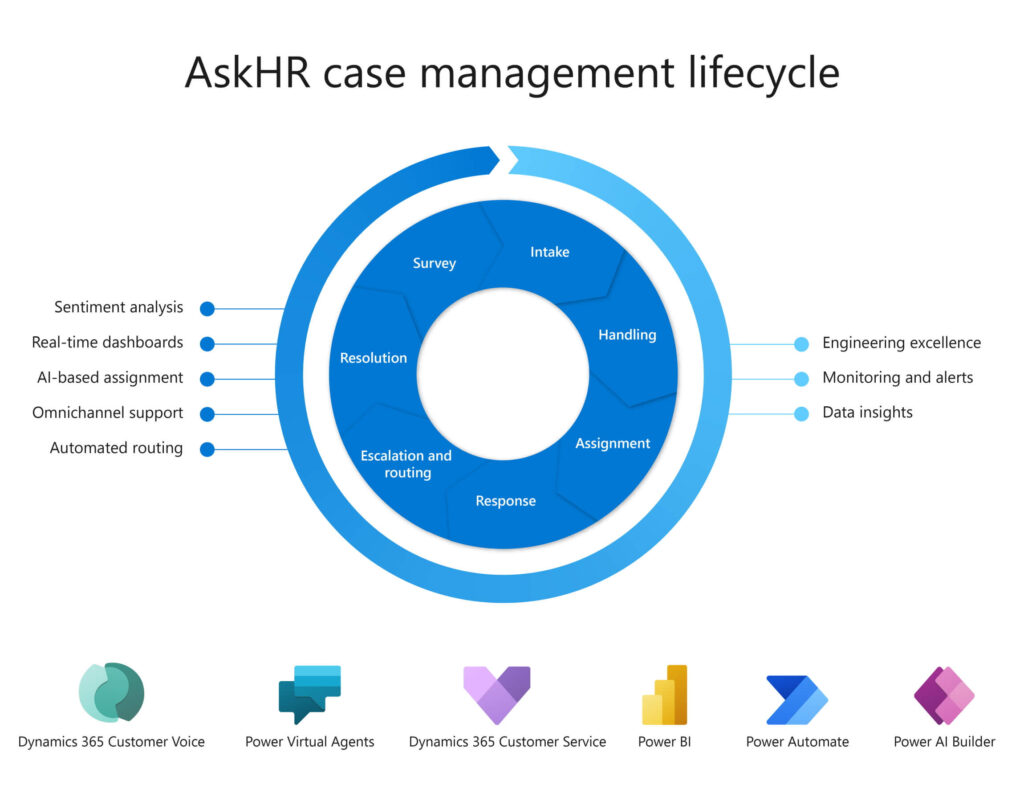 A decade ago, an email inbox was the primary tool that Microsoft Human Resources (HR) used to interact with employees. Today, Dynamics 365 and Microsoft Power Platform have transformed how Microsoft HR connects with and serves employees through our internal employee engagement platform, AskHR. Powered by Dynamics 365 Customer Service, AskHR is a core, critical component in managing Microsoft HR interactions with employees across more than 1 million inquiries per year. AskHR has improved our employee experience across Microsoft, creating a more efficient and enjoyable experience for our users and the HR advisors who support them through the engagement process.
A decade ago, an email inbox was the primary tool that Microsoft Human Resources (HR) used to interact with employees. Today, Dynamics 365 and Microsoft Power Platform have transformed how Microsoft HR connects with and serves employees through our internal employee engagement platform, AskHR. Powered by Dynamics 365 Customer Service, AskHR is a core, critical component in managing Microsoft HR interactions with employees across more than 1 million inquiries per year. AskHR has improved our employee experience across Microsoft, creating a more efficient and enjoyable experience for our users and the HR advisors who support them through the engagement process.
Engaging our employees with AskHR
AskHR is our internal employee-engagement application that Microsoft Digital (the IT organization) built for supporting inquiries to Microsoft’s HR department and managing ongoing cases related to those inquiries. Our employees use the app to submit many diverse requests, from ones as basic as “Where can I get drinking water?” or “How do I apply for a specific benefit?” to more complex cases like moving to a new location or job or dealing with an illness. Based on these requests, the team of advisors at Microsoft HR engages with employees to ensure that their requests are fulfilled in a timely and efficient manner.
AskHR supports an intake of more than 4,500 new inquiries per day, using an array of channels, including email and web integrations with other HR platforms. Our global AskHR team consists of more than 1,400 HR advisors spread across 12 HR functions and divided into more than 250 HR support teams. Microsoft has more than 220,000 global employees.
Employee inquiries have been increasing exponentially in parallel with the increase in employees hired each year at Microsoft. In the past 10 years, we’ve gone from supporting a few thousand inquiries a year, to supporting more than 1 million employee inquiries and transactions annually. In addition, we now have rigid controls around access provisioning, review, country/region-mandated compliance, General Data Protection Regulation (GDPR), and annual privacy reviews. We’ve also broadened our request intake mechanisms from email-based intakes to several other intake channels including Web API and virtual agent. Processes supported by AskHR include:
Support for global new-hire onboarding and internal employee transfer. We use AskHR for the complete employee onboarding process for new employees and employees transferring to new positions and business groups within Microsoft.
Support for former employees’ queries related to their employment history. Former employees can use AskHR to retrieve personnel files even after they’re no longer a Microsoft employee.
Transactional queries and access management for data-management teams. Our data teams can capture important insights across all aspects of the employee-inquiry process.
Employee and dependent benefits queries. All benefits queries are channeled through AskHR, and employees can retrieve applicable information and processes for researching or claiming benefits.
Complex employee inquiries. Hundreds of requests come through AskHR each day that range from hybrid-work support to employee performance to policy and governance reference. Many of these require specific involvement of HR staff and complex case-management activities.
Center of Excellence support queries. Many company programs originating from our central HR teams including rewards and hybrid work leverage AskHR as the primary employee experience interface to address questions and, where appropriate, route to experts for further consultation.
AskHR gives Microsoft HR the ability to react quickly to changes within our corporate environment. When COVID-19 hit, we were able to organize and prioritize pandemic-related cases, allocate advisors to the proper queues, and shift the focus of our HR support to meet needs on an ongoing basis, whether day-to-day or week-to-week, as different demands and situations came and went.
—Andrew Winnemore, general manager, HR Services
The need for AskHR reflects a larger trend in which HR—and the integral role it plays in key decisions—is becoming central to operations for companies of all sizes. With this change, the role of how HR engages with organizations’ employees has also shifted. For example, it’s understood that retaining employees today requires more than competitive compensation and benefits. Microsoft and other organizations must also consider how they engage with employees in critical support scenarios, while making sure that engagement is performed in a timely, relevant, and authentic manner.
“AskHR gives Microsoft HR the ability to react quickly to changes within our corporate environment,” says Andrew Winnemore, a vice president in HR Services. “When COVID-19 hit, we were able to organize and prioritize pandemic-related cases, allocate advisors to the proper queues, and shift the focus of our HR support to meet needs on an ongoing basis, whether day-to-day or week-to-week, as different demands and situations came and went.”
Transforming HR interaction with Dynamics 365 and Microsoft Power Platform
We’re transforming the way we interact with our employees on AskHR with Dynamics 365 Customer Service and Power Platform. The tools and capabilities that these solutions provide have enabled us to build a robust and resilient employee engagement system that both our employees and advisors love to use.
We’ve built our entire HR support platform around Dynamics 365 Customer Service and Power Platform technologies. We’re using many of the built-in capabilities to better support Microsoft HR. Using technologies including AI and machine learning, Power Virtual Assistant, Power Automate, Microsoft Teams collaboration, and Customer Voice, we’ve enabled Microsoft HR to deliver a highly intuitive employee interaction solution that engages our employees in ways that were previously only equated with customer interactions.
—Mahesh Sharma, director, AskHR Cross Industry Solutions
Dynamics 365 Customer Service provides a suite of capabilities that enable us to deliver the best experience for our employees and HR advisors throughout the inquiry and case-management process. With its omnichannel capabilities, Customer Service allows Microsoft HR advisors to take customer requests from many different avenues, manage multiple sessions at a time, interact with multiple apps without losing context, and enhance their workflow with productivity tools.
AskHR is built around the core of Dynamics 365 Customer Service and Power Platform. Most AskHR functionality is hosted in Dynamics 365 Customer Service and supported by other Dynamics 365 components and solutions built from the Power Platform. Examples of this functionality include HR case management, employee interaction, knowledge-base management, service-level agreement (SLA) management, and sentiment analysis.
“We’ve built our entire HR support platform around Dynamics 365 Customer Service and Power Platform technologies,” says Mahesh Sharma, a former AskHR Engineering PM Lead in Microsoft Digital. “We’re using many of the built-in capabilities to better support Microsoft HR. Using technologies including AI and machine learning, Power Virtual Assistant, Power Automate, Microsoft Teams collaboration, and Customer Voice, we’ve enabled Microsoft HR to deliver a highly intuitive employee interaction solution that engages our employees in ways that were previously only equated with customer interactions.”
Additional capabilities in AskHR are supported by several Dynamics 365 services and Microsoft Power Platform–built capabilities:
Dynamics 365 Customer Voice. Dynamics 365 Customer Voice supports our employee feedback process with survey forms and workflows that are easy to create and manage. Customer Voice offers an agile and user-friendly interface to manage surveys that helps ensure that our employees feel empowered and encouraged to provide open-ended feedback. Employees can also provide timely and near-immediate feedback directly from the email they receive, which makes it more intuitive for them to respond to. These changes have increased our survey response from 9 percent to 22 percent over the last year.
Dynamics 365 Customer Service Insights and Microsoft Power BI. Real-time reporting, insights, and analytics are an important part of day-to-day operational decisions by our advisors and key planning decisions by HR leadership. Customer Service Insights uses AI and analytics capabilities to identify and predict trends and other insights. The real-time insights that we receive from Customer Service Insights provide managers with business-critical information on the case volumes within their teams and trending topics that help them to better coordinate with other HR teams. The Key Performance Indicators (KPIs) and metrics built into Power BI reports are used to inform most HR-related support decisions.
Dynamics 365 Customer Service Knowledge Management. Our HR teams use Microsoft Knowledge Base articles to curate, maintain, and govern responses to thousands of common requests using a single point of management and a common feedback loop. This process ensures that the articles are accurate and current. It also provides a single repository of answers for employees, eliminates duplication of materials, and reduces circulation of conflicting information.
Power Virtual Agent. Our Power Virtual Agent chat bot is becoming the default first triage agent on the web for AskHR. Power Virtual Agent has been managing approximately 15 percent of all AskHR inquiries globally. It’s emerging as the fastest growing method to respond to our employee inquiries and reduce the ever-increasing burden on our advisors due to the growth of our employee population over the past few years.
Power Platform AI Builder. We use AI Builder to analyze user sentiment, predict HR case activities, and triage cases to the appropriate queues. AI Builder provides prebuilt models and the ability to create custom models that support scenarios relevant to AskHR. These models continually learn and refine their behavior based on AskHR data. The models inform many aspects of employee engagement, including case routing, sentiment analysis, spam filtering, and automation activities.
Power Automate. We use Power Automate to simplify and expedite communication and process workflow activities throughout AskHR. These include notifying an advisor when a case is assigned to them, sending out an acknowledgement when employees create a case, or generating notifications whenever activities need to be created based on an event.
Generating business and technical value with native functionality
In an organization as large as Microsoft, the HR environment is broad and complex. Using Dynamics 365 and Power Platform enables us to achieve quality, resiliency, flexibility, and accurate observation in AskHR that far exceeds the capabilities of our previous solution and requires far less customization.
Deep collaboration with our Dynamics 365 and Power Platform product groups has helped us deliver several advanced HR-related features, avoiding costly customizations. This has been a very symbiotic relationship where we proactively reach out to them for capabilities we want in the product and where they reach out to us to help validate future functionality they’re building into the product.
—Gayatri Garapati, AskHR engineering SWE lead, Microsoft Digital Employee Experience
Most functionality that we use in AskHR is based on native, out-of-the-box features supported by Dynamics 365 and Power Platform Services, which handle our large array of HR needs, from managing onboarding for almost 200 employees per month to ensuring that questions about benefits and resources are answered quickly and effectively. As a result of this simplicity, our design and engineering principles and practices are more easily achievable, and more robust and reliable.
Engineering excellence
Microsoft HR and Microsoft Digital are Customer Zero for Dynamics 365 Customer Service and Power Platform product group teams. By collaborating actively with the product groups, we help them implement several features that are critical to not only our HR needs but also to many external customers. As Customer Zero, we work with the product group teams, testing features and ensuring that the design and quality are completely ready for production environments before features are released for General Availability. At any given time, we have several Customer Service and Power Platform features in beta release that we’re co-innovating on with the product group.
“Deep collaboration with our Dynamics 365 and Power Platform product groups has helped us deliver several advanced HR-related features, avoiding costly customizations,” says Gayatri Garapati, an AskHR engineering SWE lead in Microsoft Digital. “This has been a very symbiotic relationship where we proactively reach out to them for capabilities we want in the product and where they reach out to us to help validate future functionality they’re building into the product.”
Monitoring and alerts
We have alerts created for all applicable scenarios across AskHR use cases. We can audit alerts, perform proactive monitoring, and consolidate alerts as a result. The alerting system connects directly with our operations management and ticketing systems, using out-of-the-box capability. We use several monitoring scenarios and alerts to ensure that our employees and advisors receive the optimal HR experience and notify our engineering teams of potential issues. Some key examples include:
- Intake activities that aren’t converted to tickets.
- Emails that aren’t successfully sent to customers when advisors respond.
- Employee information that doesn’t match data stored in Azure Active Directory.
Data insights
Built-in data insight capability lets us leverage all data sources that support AskHR. We have reporting capabilities within each component, but also the capability to report across the entire AskHR landscape with Power BI. AI and machine learning capabilities support data analysis that helps our advisors and leadership understand all aspects of employee engagement.
For example, our Escalation Management dashboard helps HR teams identify important and urgent requests coming through AskHR. We introduced sentiment analysis as part of the Escalation Management dashboard to better understand escalation needs across employee requests, even if the employee didn’t mark the request as urgent in the interface. Sentiment analysis parses all inbound correspondences and communications from the employee, then identifies occurrences of negative sentiment or urgency and marks such cases as potential escalations. Escalation management functionality also reviews other information such as the number of queue hops and number of times a case is reopened to also flag them as potential escalations. These potential escalations are moved to the top of their queues so that HR advisors can proactively address these cases before they truly become escalations. Sentiment analysis has flagged more than 250,000 inbound conversations to date.
Driving dynamic and intelligent case-management activities
Dynamics 365 Customer Service and Microsoft Power Platform enable our advisors and employees to work across the entire span of AskHR activities seamlessly and interactively, with real-time responsiveness and trackable processes. The following list contains the supported activities and components:
- Intake. Case intake is the entry point for employees to submit requests to Microsoft HR. AskHR uses Dynamics 365 Customer Service, Power Virtual Agents, and Microsoft Azure API Management to support a huge array of intake channels including our web-based portal, Virtual Agent, email, and API.
Example: An employee in California uses the web portal to contact HR support requesting details on parental leave and policies. The AI builder model parses the details of the incoming conversation and associated employee metadata and identifies the Benefits Service Line as the best team to support the request. The case is routed to the queue for US benefits support. - Handling. HR advisors need to understand and categorize incoming requests in preparation for engaging with employees to resolve a concern. Power Platform AI Builder, Power Apps component framework, and Dynamics 365 dashboards enable our advisors to capture case details quickly and easily by using AI for classification and sentiment analysis and providing relevant contextual information.
Example: A benefit-related case raised by an US-based employee, flagged for urgent attention, surfaces onto a queue manager dashboard. The queue manager consults a real-time availability dashboard and assigns the case to an available advisor who specializes in US benefits policies. - Assignment. Advisors are responsible for ensuring that cases are triaged properly and assigned to appropriate team members for resolution, but they don’t need to do all the work. AskHR uses Power Automate Workflow and the Dynamics 365 plugin framework to support automated triage for most activities, while routing difficult assignments to advisors for quick, efficient triage.
Example: Upon receiving a new case in their dashboard, the advisor checks recent case history and other work-related details for the employee, using the contextual information associated with the case. They use Teams collaboration to reach out to a benefits specialist consultant to gather more information and ask questions. They can add notes into the case details. - Response. Advisors engage with employees to provide answers, perform a transaction, gather information, or determine if they need to involve another team member in the case. AskHR provides automated insertion of knowledge-base articles into cases, use AI-based intelligent pre-search for surfacing relevant articles, and sentiment analysis to understand employee sentiment.
Example: Advisor responds back to the employee with a Dynamics 365 article that answers the inquiry and provides some real-time details. - Escalation and routing. AskHR supports automated escalation and routing across many scenarios, including employee sentiment, case lifecycle, and case classification. AI Builder and Power BI dashboards enable our advisors to manage and observe escalation and routing behavior at any point in the lifecycle.
Example: After the employee has reviewed the details requested, they want to follow through with the parental-leave process. The benefits advisor contacts the employee to understand the details of their query. At any point in the escalation and routing process, the advisor might consult with subject matter experts in the query subject area, including the Center of Excellence program team. - Resolution. Ensuring that a case is resolved properly is critical to engaging our employees effectively. AskHR uses Dynamics 365 Customer Service case categorization and the PowerApps control framework to provide advisors with the functionality they need to confirm resolution efficiently.
Example: Having clarified all employee questions, the benefits advisor is ready to resolve the case. They verify the categorization done earlier and add closing case metadata that will help with analytics. - Survey. After resolution, AskHR uses Dynamics 365 Customer Voice to collect employee feedback. Power BI reports and dashboards are in place to help advisors and Microsoft HR leadership identify successes and opportunities for improvement throughout the case-management lifecycle.
Example: When the case is marked as resolved, a survey is automatically sent to the employee. Upon survey completion, the consultant’s manager can check the employee’s feedback and ratings for HR support.

AskHR uses Dynamics 365 and Microsoft Power Platform to support the case management lifecycle at Microsoft HR.
Next steps
We’re not done. This is a continuous journey and we’re focusing on improvements to several areas, including advisor productivity, process automation, and live assistance. We’re also working with the product group to add and improve Dynamics 365 Customer Service capabilities, including unified routing, improved knowledge management, and deeper natural language understanding AI.
The HR advisors and front-end line managers love the low code flexibility that Power Automate provides. It helps them support complex business processes, while still working within the constructs of a well-defined case-management lifecycle. This allows the engineering team to focus on critical infrastructural and technological advancements, while HR advisors are empowered to create flows that best support their processes in a rapid and efficient manner. We’ve seen a steady 20 percent year-over-year increase in adoption of the platform through some of the most complex employee scenarios presented by COVID-19, hybrid workplace management, and employee investigations.
—Abhinav Jhingan, AskHR HR solution lead, HR Services
With Dynamics 365 Customer Service and Microsoft Power Platform, AskHR has been resilient, scalable, and dependable, while giving us the freedom to adapt AskHR functionality to change and grow with our organization. We expect that flexibility to continue to improve as we seek to increase employee engagement, better support our advisor user base, and prepare for future HR-specific needs at Microsoft.
“The HR advisors and front-end line managers love the low code flexibility that Power Automate provides,” says Abhinav Jhingan, an AskHR HR solution lead in HR Services. “It helps them support complex business processes, while still working within the constructs of a well-defined case-management lifecycle. This allows the engineering team to focus on critical infrastructural and technological advancements, while HR advisors are empowered to create flows that best support their processes in a rapid and efficient manner. We’ve seen a steady 20 percent year-over-year increase in adoption of the platform through some of the most complex employee scenarios presented by COVID-19, hybrid workplace management, and employee investigations.”

Continued adoption of Dynamics 365 and Microsoft Power Platform features across AskHR has delivered significant benefits for our HR users. Movement to our browser-based unified client interface has saved more than 3,000 advisor hours each month due to the streamlined interface. Our AI-based spam model has helped eliminate hundreds of thousands of incoming spam emails at 97.89 percent accuracy. We’ve also used AI to interpret user sentiment for approximately 1.4 million employee messages in the last six months. We’ve seen significant improvement in several areas of employee engagement and HR efficiency, including:
- Reduced case resolution time. Due primarily to automatic routing and contextual data sharing, we’ve reduced case resolution time by 18 hours per case, on average.
- Improved NSAT ratings. Our net satisfaction (NSAT) rating for employees and advisors has increased by almost 10 percent.
- Improved advisor productivity. Our advisors are spending approximately 12 minutes less per case than they did before AskHR.
- Increased first-time fix rates. Our rate for fixing an issue or closing a case after the first point of HR contact is 29 percent.

- Learn how Microsoft is helping its employees understand their value with the Total Rewards Portal.
- Find out how Microsoft is updating its core Human Resources system with SAP SuccessFactors.
- See how Microsoft is reinventing the employee experience for a hybrid world.
Tags: Dynamics 365, Power Platform








